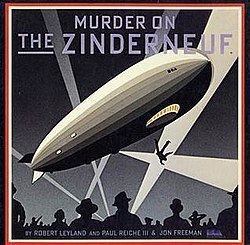6 /10 1 Votes6
| 3/5 My Abandonware Initial release date 1983 | |||||||||||||||||||||||||||||||||
 | ||||||||||||||||||||||||||||||||||
Programmer(s) Robert LeylandAlan Pavlish Paul Reiche III games Mail Order Monsters, Archon II: Adept, Archon: The Light and the D, Star Control, World Tour Golf | ||||||||||||||||||||||||||||||||||
Murder on the zinderneuf gameplay pc game 1984
Murder on the Zinderneuf is 1983 computer game designed by Jon Freeman and Paul Reiche III and one of the first six games published by Electronic Arts. It was developed for the Apple II, Commodore 64, Atari 8-bit family, and the PC as a booter.
Contents
- Murder on the zinderneuf gameplay pc game 1984
- Murder on the zinderneuf for the pc booter
- Plot
- Gameplay
- Detectives
- Suspects
- Influences
- Reception
- References
The Apple II version was programmed by Alan Pavlish of Designer Software. All other versions were programmed by Robert Leyland. The Commodore 64 version states it was by Mission Accomplished, Inc., but also gives credit to Leyland for programming.
Murder on the zinderneuf for the pc booter
Plot
The game is set in 1936. The player is a detective traveling across the Atlantic aboard the world's most luxurious dirigible, the Zinderneuf. The craft is full of high-profile personalities from all walks of life. A murder takes place aboard the Zinderneuf, and it is up to the player to identify the culprit before the ship lands.
Gameplay
The player is given a choice of eight detectives to play, each with a distinct personality. They must then search the rooms of the dirigible for possible clues, as well as interview passengers to identify the killer. The detective must carefully chose his or her method of questioning suspects. Choosing the right approach means that a character is more likely to offer useful clues.
Once they are satisfied that they have a culprit, the detective has the option of accusing them directly, or waiting until enough clues are found to prove their hunch. If they are wrong, the person they have accused will not speak to them for the remainder of the game. A denial does not always mean the detective is wrong, only that more proof is required for the murderer to confess.
If the detective is correct, the killer will explain the motives behind their crime, and the detective is given one of six ratings based on the effectiveness of their investigation:
The player is presented with a different murderer and victim each time the game is played. This, combined with the depth of narrative detail in the stories and characters, makes the game highly replayable. Each real-time game finishes in 36 minutes to encourage many replays.
Detectives
Suspects
Influences
Designer Jon Freeman stated in the December 1980 BYTE that "a game like Adventure is really a puzzle that, once solved, is without further interest"; by contrast, he wrote, computer role-playing games like his Dunjonquest series offer unpredictable play and replay opportunities. Murder on the Zinderneuf is an adventure game, but by randomly generating stories it is replayable. Freeman said that the game was a homage to the classic board game, Cluedo, but there are obvious influences from books and movies in the mystery genre, ranging from Agatha Christie's Miss Marple and Hercule Poirot books, to Sherlock Holmes and the films of Humphrey Bogart. A number of famous personalities from the 1930s may also have inspired the creation of the passengers aboard the Zinderneuf, such as Veronica Lake (Veronica Marlowe), Johnny Weissmuller (Buck Battle), and Hedda Hopper (Margaret Vandergilt).
Reception
The earliest version (i.e. the Atari version) of Murder on the Zinderneuf was reviewed by Video magazine in its "Arcade Alley" column magazine shortly after release. Reviewers noted that the game is "as entertaining as it is innovative", and described it as "one of the most distinctive titles to be published [in 1983]". Specific praise was given the game's replay option which offers a different fact pattern for each playthrough. Computer Gaming World was particularly impressed with Murder on the Zinderneuf's 1930s characters, each with colorful, easily distinguished graphics. Praise was given for attention to particular details, such as the engine noise increasing as the player moves towards the back of the zeppelin. In addition to the game being fair and winnable, the reviewers reported playing the game twenty times, only seeing two repeat "confessions", in illustration of the game's numerous different plots. Softline stated that Free Fall "came up with a game that's every bit as delightful as Archon was".Ahoy! called Murder on the Zinderneuf "the most intriguing mystery game I have ever played ... for a mystery fan it is a dream come true". PC Magazine gave the game 15.0 points out of 18, noting the importance of acting in accordance with the chosen detective character's personality when questioning suspects.
Historian Jimmy Maher in 2013 wrote that "There's much that's very impressive here. The randomly-generated cases go far beyond the likes of Colonel Mustard in the drawing room with the pistol". He added, however, that "Zinderneuf doesn't quite work for me". Maher criticized the background material appear in the manual instead of the game, and stated that "For all the game's narrative flexibility, there are just eight master stories" that repeat while "there just isn't that much to really do, and what there is is often more frustrating than it needs to be". He concluded that "Murder on the Zinderneuf is fascinating and groundbreaking as a concept" but not very fun, preferring its contemporary Deadline which was not replayable but more "clever".
